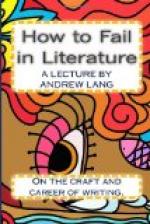These are words which the writer should have always present to his memory, if he has something serious that he wants to say, or if he wishes to express himself in the classic and perfect manner. But if it is his fate merely to be obliged to say something, in the course of his profession, or if he is bid to discourse for the pleasure of readers in the Underground Railway, I fear he will often have to forget Mr. Pater. It may not be literature, the writing of causeries, of Roundabout Papers, of rambling articles “on a broomstick,” and yet again, it may be literature! “Parallel, allusion, the allusive way generally, the flowers in the garden”—Mr. Pater charges heavily against these. The true artist “knows the narcotic force of these upon the negligent intelligence to which any diversion, literally, is welcome, any vagrant intruder, because one can go wandering away with it from the immediate subject . . . In truth all art does but consist in the removal of surplusage, from the last finish of the gem engraver blowing away the last particle of invisible dust, back to the earliest divination of the finished work to be lying somewhere, according to Michel Angelo’s fancy, in the rough-hewn block of stone.”
Excellent, but does this apply to every kind of literary art? What would become of Montaigne if you blew away his allusions, and drove him out of “the allusive way,” where he gathers and binds so many flowers from all the gardens and all the rose-hung lanes of literature? Montaigne sets forth to write an Essay on Coaches. He begins with a few remarks on seasickness in the common pig; some notes on the Pont Neuf at Paris follow, and a theory of why tyrants are detested by men whom they have obliged; a glance at Coaches is then given, next a study of Montezuma’s gardens, presently a brief account of the Spanish cruelties in Mexico and Peru, last—retombons a nos coches—he tells a tale of the Inca, and the devotion of his Guard: Another for Hector!
The allusive style has its proper place, like another, if it is used by the right man, and the concentrated and structural style has also its higher province. It would not do to employ either style in the wrong place. In a rambling discursive essay, for example, a mere straying after the bird in the branches, or the thorn in the way, he might not take the safest road who imitated Mr. Pater’s style in what follows:
“In this way, according to the well-known saying, ‘The style is the man,’ complex or simple, in his individuality, his plenary sense of what he really has to say, his sense of the world: all cautions regarding style arising out of so many natural scruples as to the medium through which alone he can expose that inward sense of things, the purity of this medium, its laws or tricks of refraction: nothing is to be left there which might give conveyance to any matter save that.” Clearly the author who has to write so that the man may read who runs will fail if he wrests this manner from its proper place, and uses it for casual articles: he will fail to hold the vagrom attention!




